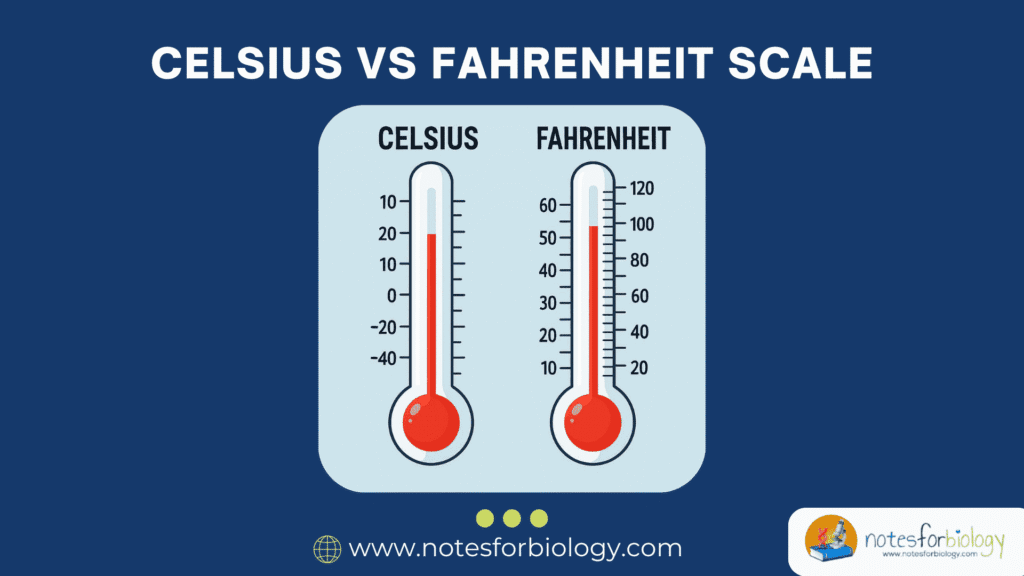Temperature is one of the most fundamental physical quantities measured in everyday life, from weather forecasting to cooking, scientific research, and international travel. Different parts of the world use different temperature scales, with Celsius and Fahrenheit being the two most common systems. Understanding how these scales differ is essential for interpreting weather reports, using scientific data, and adjusting to travel in countries that use unfamiliar units.
Historically, both Celsius and Fahrenheit scales were developed for practical reasons based on available instruments and regional needs. Over time, they became standards in different parts of the world, and today, both systems remain in use for different purposes.

Summary of Celsius vs Fahrenheit Scale
- The Celsius vs Fahrenheit scale debate centers on different reference points. Celsius uses 0° (freezing) and 100° (boiling) for water, while Fahrenheit uses 32° and 212°.
- The Celsius vs Fahrenheit scale divide reflects global preferences, with Celsius dominating science and most countries, while Fahrenheit persists in the U.S. for its finer weather gradations.
- The Celsius vs Fahrenheit scale conversion is simple: °F = (°C × 9/5) + 32 (e.g., 30°C = 86°F) or °C = (°F − 32) × 5/9 (e.g., 50°F = 10°C).
Table of Contents
What is the Celsius Scale?

Definition and Origin of Celsius
The Celsius scale, originally known as the centigrade scale, was developed by Swedish astronomer Anders Celsius in 1742. He based the scale on two fixed temperature points: the freezing point of water at 0°C and the boiling point of water at 100°C under standard atmospheric pressure. The scale was initially reversed, with 0 as the boiling point and 100 as the freezing point, but it was later flipped to its modern form by Carl Linnaeus.
The Celsius scale is part of the metric system and is widely used in scientific, educational, and daily life contexts in most countries worldwide.
Common Applications of Celsius
Celsius is the standard temperature measurement in most countries, especially those using the metric system. It is employed in weather forecasting, cooking instructions, medical readings like body temperature, and almost all scientific work, including physics, chemistry, and environmental science. Laboratory equipment such as thermometers, incubators, and ovens typically display temperatures in Celsius for uniformity and accuracy.
What is the Fahrenheit Scale?
Definition and Origin of Fahrenheit
The Fahrenheit scale was introduced by German physicist Daniel Gabriel Fahrenheit in 1724. He established the zero point of his scale based on the lowest temperature he could create using a mixture of ice, water, and ammonium chloride. The freezing point of water was set at 32°F, and the boiling point at 212°F under standard atmospheric pressure, making a total of 180 degrees between these two key points.
The Fahrenheit scale was historically popular in English-speaking countries and remains in use in the United States and a few Caribbean nations.
Common Applications of Fahrenheit
Fahrenheit continues to be the preferred system for everyday temperature measurement in the United States, covering weather reports, cooking guidelines, and household thermostats. While scientific and medical communities in the US largely rely on Celsius for standardization, Fahrenheit remains embedded in cultural practices and public communication.
Celsius vs Fahrenheit: 10 Key Differences
Understanding the differences between Celsius and Fahrenheit involves comparing their definitions, scale increments, and practical uses.
Definition of Zero Point
On the Celsius scale, zero degrees represents the freezing point of water. In contrast, zero on the Fahrenheit scale is based on a salt-ice mixture, a historical reference point unrelated to water’s freezing temperature. This distinction in zero points affects how each scale is structured and applied.
Boiling Point of Water
The boiling point of water on the Celsius scale is 100°C under normal atmospheric pressure. In the Fahrenheit system, water boils at 212°F. The difference highlights the unequal size of the degree increments in the two scales.
Freezing Point of Water
Water freezes at 0°C on the Celsius scale and at 32°F on the Fahrenheit scale. This consistent discrepancy of 32 degrees reflects one of the most practical differences to remember when converting between the two.
Number of Degrees Between Freezing and Boiling Points
There are 100 degrees between water’s freezing and boiling points on the Celsius scale, while the Fahrenheit scale has 180 degrees for the same temperature range. This makes Fahrenheit degrees smaller than Celsius degrees, as it takes 180 Fahrenheit degrees to cover the same range as 100 Celsius degrees.
Use in Countries (Metric vs. Imperial Systems)
Most of the world, especially countries using the metric system, employs Celsius for everyday and scientific purposes. Countries such as the United States, Liberia, and the Cayman Islands continue to use Fahrenheit for public temperature reporting and domestic measurements, reflecting historical preferences.
Scientific and Academic Preference
Internationally, the scientific community uses Celsius as the standard for temperature measurement due to its compatibility with the metric system and the SI (International System of Units). Most scientific papers, laboratory records, and academic instructions worldwide express temperatures in Celsius for consistency.
Ease of Everyday Use and Intuition
For many people, Celsius is considered more intuitive because it directly relates to the freezing and boiling points of water, two easily observable physical events. In Fahrenheit, room temperature and human body temperature fall within ranges historically regarded as comfortable, making it suitable for domestic and meteorological use in regions familiar with this system.
Formula for Conversion Between Scales
Converting between Celsius and Fahrenheit requires a specific mathematical formula:
- To convert from Celsius to Fahrenheit:
(°C × 9/5) + 32 = °F - To convert from Fahrenheit to Celsius:
(°F − 32) × 5/9 = °C
These formulas account for the different zero points and scale intervals, ensuring accurate conversion across measurements.
Applications in Meteorology
Meteorological services worldwide predominantly use Celsius, providing weather forecasts, climate data, and environmental monitoring in this unit. In the United States, public weather broadcasts and reports still use Fahrenheit, although scientific climate reports typically include Celsius as well.
Cultural and Historical Relevance
Celsius became popular in the 20th century as part of the widespread adoption of the metric system. Fahrenheit, however, maintains cultural relevance in the United States, where it is deeply embedded in weather forecasts, cooking, and everyday temperature references.
Practical Examples Comparing Celsius and Fahrenheit
To better understand how these scales compare, it helps to look at real-life examples.
Example: Normal Human Body Temperature
The average normal human body temperature is approximately 37°C. In Fahrenheit, this is equivalent to 98.6°F. This is one of the most frequently cited temperature conversions in healthcare settings.
Example: Room Temperature
Comfortable indoor room temperature is around 20°C to 22°C, corresponding to 68°F to 72°F. This range is typically used for climate control and home heating/cooling settings.
Example: Summer and Winter Temperatures
A hot summer day might reach 30°C to 35°C (86°F to 95°F), while a cold winter day might fall to 0°C (32°F) or below in colder regions. These values help travelers prepare for weather conditions when visiting countries using different temperature scales.
Example: Cooking Temperatures
Oven temperatures in recipes may be stated as 180°C for moderate heat, which converts to 356°F. Understanding these conversions is vital for following international recipes accurately.
Why Two Different Temperature Scales Exist
Historical Development of Measurement Systems
Both scales emerged during a time when standardization was limited, and measurement systems were regionally developed to address local needs. Celsius was aligned with metric measurements for scientific precision, while Fahrenheit was tailored for practical domestic use.
Regional Preferences and Standardization
Cultural and historical preferences led some countries to retain the Fahrenheit system while others adopted Celsius for compatibility with the metric system and international scientific standards. Over time, the need for global consistency in science encouraged broader adoption of Celsius.
How to Convert Between Celsius and Fahrenheit
Conversion Formulae Explained
As mentioned, the formulas to convert temperatures are:
- Celsius to Fahrenheit: (°C × 9/5) + 32
- Fahrenheit to Celsius: (°F − 32) × 5/9
These formulas allow precise conversion and are essential tools in fields ranging from international travel to laboratory work.
Quick Mental Math Tips for Travelers
Travelers can use rough approximations for quick conversions:
- To estimate Celsius to Fahrenheit: double the Celsius value and add 30.
- To estimate Fahrenheit to Celsius: subtract 30 from Fahrenheit and halve the result.
Though not exact, these shortcuts help in casual, non-critical situations like checking weather forecasts.
Modern Global Temperature Standards
The Global Move Toward Celsius in Science
Today, Celsius is the preferred unit in science, industry, and most government regulations. International organizations such as the World Meteorological Organization and International System of Units endorse its use, further solidifying its global presence.
Exceptions and Continued Use of Fahrenheit
Despite this trend, Fahrenheit remains deeply rooted in everyday use in the United States and a few other regions. Public temperature readings, household appliances, and weather services continue to report temperatures in Fahrenheit, preserving its relevance in certain cultural contexts.
Conclusion
In summary, while both the Celsius and Fahrenheit scales measure the same physical property, their differences in origin, application, and practicality set them apart. Understanding their distinctions is crucial for interpreting temperatures in science, medicine, travel, and daily life. Though Celsius has become the global scientific standard, Fahrenheit’s continued use in specific countries adds a cultural dimension to temperature measurement. Being familiar with both systems ensures clarity and effective communication in an increasingly interconnected world.
Frequently Asked Questions (FAQ)
Which temperature scale is more accurate?
Both Celsius and Fahrenheit are equally accurate because they measure the same temperature range, just with different unit sizes. Accuracy depends more on the thermometer used than the scale itself.
Why does the U.S. still use Fahrenheit?
The U.S. continues to use Fahrenheit mainly due to tradition and everyday familiarity. It’s deeply embedded in culture, weather reporting, and common use, so changing would require a big adjustment.
How do scientists decide which temperature scale to use?
Scientists usually use Celsius because it fits the metric system and is easier to work with in calculations. It’s internationally accepted in scientific research and communication for consistency.
Related Contents
Cell Wall Synthesis Inhibitors: Examples, Mechanisms of Inhibition, and Resistance Strategies
Cell Proliferation – Definition, Assay, Differentiation, Diseases




